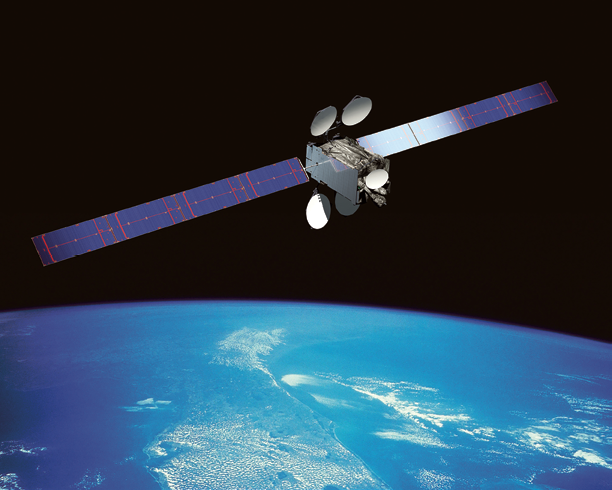Chris Hudson is the Senior Solutions Architect Engineer at Intelsat General, and MilsatMagazine offers his in-depth expertise regarding the company’s various , upcoming Intelsat EpicNG projects, and his successful career.

MilsatMagazine
Mr. Hudson, given the technical expertise you bring to Intelsat General, many of our readers would be interested in learning about your background—how did you decide to enter the engineering field and, then, what drew you to Intelsat General Corporation?
Chris Hudson
Even though I was an Engineering Physics major in college, I co-oped and later worked full time building satellites at Hughes Space and Communications Group (now Boeing Satellite Systems). I moved back east and worked at Spacenet, ComSoft Systems (now iDirect), and, for the past 17 years, at Intelsat and Intelsat General.
MilsatMagazine
How did you become involved with ICG’s Intelsat EpicNG satellite projects?
Chris Hudson
Intelsat EpicNG satellites are being designed, built and launched by IGC’s parent corporation, Intelsat. I explain to IGC’s customers how Intelsat EpicNG is radically different from existing satellite designs and why this is important to their applications and needs.
MilsatMagazine
Please tell us about Epic Next Generation (Intelsat EpicNG) and the development of this High Throughput Satellite (HTS) and the role Boeing plays.
Chris Hudson
Intelsat EpicNG represents a major satellite design breakthrough for increased throughput and efficiencies. This satellite system is the next step in the progressive evolution of our company’s leading, global satellite and terrestrial infrastructure.
Intelsat EpicNG incorporates C-, Ku- and Ka-band spot beams with unprecedented flexibility in beam-to-beam connectivity. EpicNG payloads deliver more throughput per unit of spectrum, providing technical and economic benefits for a wide range of satellite communications applications. Connectivity is provided between all beams and can be changed in orbit to meet our customers’ evolving needs. For government customers specifically, airborne ISR is a primary application. Boeing will manufacture six of the first seven EpicNG satellites.1
MilsatMagazine
How will Intelsat’s new Intelsat EpicNG satellites outperform existing Ku-band satellites for AISR missions?
Chris Hudson
Due to the tightly focused, small beam sizes, Intelsat EpicNG satellites are quite sensitive to receiving signals from small AISR terminals (high satellite G/T). In the opposite direction, those focused beams provide powerful signals to the AISR terminals (high satellite EIRP). This enables AISR terminals to transmit and receive at data rates not possible before this. In addition, these high data rates are provided more efficiently; i.e., using less satellite resources.
Here is an example. With today’s widebeam Ku-band coverages, a 45cm terminal can transmit 1Mbps and requires 5MHz of satellite resources to do so. On EpicNG, that same terminal—with no modifications—can transmit 3.7Mbps using only 4.8MHz, i.e., more throughput using less resources.
In addition, the EpicNG satellites will provide three to five times more capacity per satellite when compared to Intelsat’s existing satellites and should provide a range of up to 25-60Gbps for transmissions. This throughput will be approximately 10 times more than traditional satellite fleets.
Lastly, the high-receive sensitivity and transmit power on the satellites will lead to multiple efficiency gains and bandwidth savings specifically for AISR terminals, compared to traditional Ku-band satellites. All of these characteristics will enable performance for existing Ku-band AISR terminals that will rival or exceed Ka-band performance on the government’s Wideband Global Satcom (WGS) satellites.2
MilsatMagazine
One often stated generalization of HTS Ka-band concerns the challenge of rain-fade and the subsequent degradation of satellite signal. Several “experts” have stated that network optimization is simply not a solution to rain-fade—HTS Ka-band will never be the equal of HTS Ku-band in such weather conditions. How does Intelsat EpicNG handle this issue?
Chris Hudson
Atmospheric rain, snow or ice will absorb radio frequency signals above 11GHz, and a Ka-band signal suffers more degradation than a Ku-band signal because it has a higher radio frequency. This becomes a win for Ku- if there is sufficient rain in the region. Both rain and adjacent satellite interference degradations vary greatly, depending on a customer’s specific situation (e.g., satellite and terminal locations), so you can’t really make generalizations.
MilsatMagazine
What does the improved technology mean for the U.S. military/federal government? What makes it a valuable alternative that will meet their current and future demand?
Chris Hudson
The higher and more efficient data rates explained previously are two obvious benefits for the U.S. military / Federal government. The fact that these improvements can be realized using existing Ku-band assets is, possibly, an even larger benefit. Intelsat EpicNG provides a path forward to more capabilities for the warfighter utilizing the government’s existing knowledge base as well as the large investments in the existing hardware, training, and infrastructure.3
MilsatMagazine
As the DoD withdraws from Afghanistan and continues to lessen its demands for capabilities, do you see this lull in demand changing how much satellite bandwidth the DoD will need going into the future?

Chris Hudson
The DoD’s theater of operations is changing and will likely continue to do so into the future. As a result, the demand is naturally shifting to areas such as Africa and southeast Asia. However, the increase in cyber threats in more contested space environments will probably drive an overall increase in requirements from the DoD. In addition, we also expect the demand for high-definition video transmissions from mobile platforms to drive higher bandwidth requirements.
MilsatMagazine
You have mentioned the advantages of using existing Ku-band hardware with the Intelsat EpicNG satellites. Can you offer an example of the efficiency for a specific antenna in order that our readers may more fully understand the comparisons you make?
Chris Hudson
For ‘increased performance’, existing Ku-band terminals can transmit more Mbps. A good example, as referenced above, would be a 45cm aero antenna.1 This terminal today can transmit 1Mbps maximum on widebeam Ku-band satellites (nominal, edge of coverage area). This speed will increase by more than 3X this rate to enable 3.7Mbps transmission from the same terminal on Intelsat EpicNG (again, nominal, edge of coverage area).
Lower costs will also be possible because existing Ku-band assets will perform more efficiently on Intelsat EpicNG. With the same 45cm aero antenna example, 1MHz of satellite resources enables 0.2Mbps from the terminal today (5MHz is required for the 1Mbps transmission).
The improved performance for 1MHz of satellite resources will be 0.8Mbps from the terminal on Intelsat EpicNG (4.8MHz will be required for the 3.7Mbps transmission). Costs and investments needed to use EpicNG will be lower than retrofitting Ka-band hardware onto the majority of airborne platforms using Ku-band.

Through its flexibility and open system architecture, Intelsat EpicNG will enable the DoD to leverage deployed, Ku-band assets. In other words, the DoD can re-use its existing infrastructure that accesses Ku-band satellite resources. No purchases are necessary to access the new technology and performance of EpicNG (e.g., no forklift upgrade to Ka-band).
In addition, no new training is required; a further savings by using the existing knowledge base among users. All of these factors will lower total cost of ownership for the government at a time when budget dollars are scarce and ISR applications need higher performance as quickly as possible.
MilsatMagazine
Can you explain the market demand for enhanced Ku-band in Intelsat EpicNG, as the industry seems to be so focused these days on the advantages and uses of Ka-band?
Chris Hudson
Intelsat EpicNG High Throughput Ku-band satellites provide a means to meet ever-increasing data demands in an affordable way by leveraging the extensive Ku-band SATCOM infrastructure. Existing infrastructure includes both hardware assets as well as a widespread Ku-band SATCOM knowledge base.
My paper and presentation at MILCOM 2014, co-authored with Eric Hall of L-3 Communications Systems-West, detailed how Intelsat EpicNG can provide performance and efficiencies equivalent to WGS Ka-band. A 45cm Ka-band terminal requires 7.7 MHz of WGS resources to transmit a 10 Mbps carrier. A 45cm Ku-band terminal, transmitting the same 10Mbps, requires 7.6MHz on Intelsat EpicNG.
MilsatMagazine
Security demands continue to increase each and every day—capable adversaries are certainly not going to lessen their aggressive tactics. Please explain how Intelsat General will address this issue with the new Intelsat EpicNG system, especially as such relates to system interference and data transmission?

Chris Hudson
As the U.S. military moves into these other regions, the challenge of cyber security will increase significantly as more adversaries try to counter U.S. operations. The cyber and jamming challenges will force the military to focus on denying the adversary control of the area of operations, including the communications in that region. This concept, referred to as Anti-Access Area Denial (A2AD), has been a military priority for a long time and is even more important today with the explosive growth of cyber attacks on the critical communications architecture that the military must use to successfully achieve their missions.
The Intelsat EpicNG design inherently provides technology to meet these A2AD issues as well as a level of mitigation against interference, be it intentional or not. This is being discussed with communities of interest with the intent of developing a common understanding about what is provided today and what can be provided going forward.4
MilsatMagazine
What are the updated launch schedules for the Intelsat EpicNG satellites?
Chris Hudson
Intelsat EpicNG’s first satellite, IS 29e, is scheduled for launch and operation during the second half 2015. The second and third EpicNG-class satellites, Intelsat 32e and 33e, will launch during the first half of 2016.
MilsatMagazine
With your work in the industry, as you reflect upon your past projects, what truly brings a sense of satisfaction to you?
Chris Hudson
I am an engineer. I like to make things work. My ‘thing’ turned out to be communications. Working in this area has brought me a great sense of satisfaction because communications has, and will continue to provide, so many benefits, to so many people, in so many ways.
Editor’s note: The documents and their attendant URLs listed below fully explain in more detail Mr. Hudson’s answers in this interview.
1http://www.intelsatgeneral.com/resources/whitepaper/aisr-missions-intelsat-EpicNG-ku-band
2http://www.intelsatgeneral.com/blog/intelsat%E2%80%99s-EpicNG-ku-band-spacecraft-will-outperform-both-existing-ku-band-and-wgs-ka-band-sate
3http://www.intelsatgeneral.com/resources/whitepaper/why-ku-band-makes-most-sense-dod-over-next-few-years
4http://www.intelsatgeneral.com/blog/protected-communications-commercial-satellites


